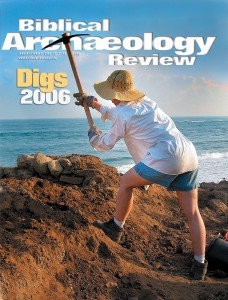Excavators at Tel Zayit, about 35 miles southwest of Jerusalem, have discovered what may be the earliest example of an abecedary—the letters of the alphabet written or carved in sequence—in what appears to be an early form of Hebrew. The two-line inscription, which is written right to left, was engraved on a 40-pound stone that had a bowl-shaped hollow on the side opposite the inscription. Based on the shape and form of the letters, the inscription appears to date from the tenth century B.C. The stone was found in secondary use, embedded in a later wall. Dig director Ron Tappy, of the Pittsburgh Theological Seminary, told the New York Times that “All successive alphabets in the ancient world, including the Greek one, derive from this ancestor at Tel Zayit.”
That stance is likely to get Tappy embroiled in the controversy over the nature of the United Kingdom—the era of kings David and Solomon—which some scholars claim was a fiction of later Biblical writers. The inscription will also be important in the debate about the extent of literacy in ancient Israel in the tenth century B.C. and whether the accounts in the Bible were passed by word of mouth or were based on texts that dated close to the time of the events they record.
The team studying the abecedary, in addition to Tappy, includes paleographer P. Kyle McCarter of Johns Hopkins University and Bruce Zuckerman of the University of Southern California, assisted by Marilyn Lundberg. Zuckerman is widely-known for his intensely detailed photographs of ancient inscriptions that often bring out features that cannot be seen with the naked eye.
Tappy has promised BAR readers a full report on the find (and the dig) in an early 2006 issue.
Already a library member? Log in here.
Institution user? Log in with your IP address.

